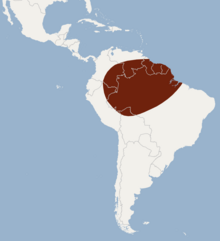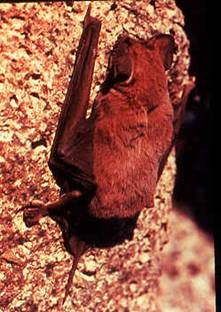
The Molossidae, or free-tailed bats, are a family of bats within the order Chiroptera. The Molossidae is the fourth-largest family of bats, containing about 110 species as of 2012. They are generally quite robust, and consist of many strong-flying forms with relatively long and narrow wings with wrinkled lips shared through their genus. Their strong flying forms allows them to fly 60 miles per hour using tail winds and at altitudes over 10,000 feet. This makes them unique among bats, as they are the only bat family that withstands the elevation. They are widespread, being found on every continent except Antarctica. They are typically found in caves, abandoned mines, or tunnels.
The name mastiff bat is applied to certain species of the bat family Molossidae or so called free-tailed bats. It is usually applied specifically to the following genera:

The black bonneted bat, also known as Shaw's mastiff bat,, is a species of bat from the Americas.

The dwarf bonneted bat, or Peters' mastiff bat,, is a bat species from South and Central America.
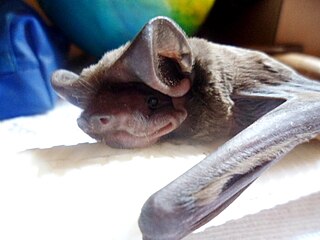
Wagner's bonneted bat or Wagner's mastiff bat, is a species of bat in the family Molossidae. It is found in the Americas from Argentina and Peru north to Mexico, and Cuba. Populations in Florida in the United States are now recognized as the Florida bonneted bat
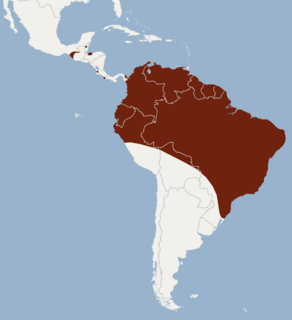
Sanborn's bonneted bat, is a bat species from South and Central America. It was first described from a specimen collected at Colonia Hansa, Brazil, and is sometimes also known as the Hansa bonneted bat.

The dwarf dog-faced bat is a species of free-tailed bat from South America. It is found in Argentina, Bolivia, Brazil, Colombia, Ecuador, Guyana, Peru, Paraguay and Uruguay, typically at lower elevations. It is one of two species in the genus Molossops, the other being the rufous dog-faced bat. Three subspecies are often recognized, though mammalogist Judith Eger considers it monotypic with no subspecies. It is a small free-tailed bat, with a forearm length of 28.9–32.5 mm (1.14–1.28 in) and a weight of 5–8 g (0.18–0.28 oz); males are larger than females. It is brown, with paler belly fur and darker back fur. Its wings are unusual for a free-tailed bat, with exceptionally broad wingtips. Additionally, it has low wing loading, meaning that it has a large wing surface area relative to its body weight. Therefore, it flies more similarly to a vesper bat than to other species in its own family. As it forages at night for its insect prey, including moths, beetles, and others, it uses two kinds of frequency-modulated echolocation calls: one type is to navigate in open areas and to search for prey, while the other type is used for navigating in cluttered areas or while approaching a prey item.

The big crested mastiff bat, is a bat species from South and Central America.

Eumops is a genus of bats in the family Molossidae. A total of 17 species of this genus have been described. The name "Eumops" comes from the Greek prefix "Eu-", meaning "good" or "true," and the Malayan word "mops," which means bat.

The western mastiff bat, also known as the western bonneted bat, the greater mastiff bat, or the greater bonneted bat, is a member of the free-tailed bat family, Molossidae. It is found in the Western United States, Mexico and South America, and is the largest bat native to North America. The subspecies Eumops perotis californicus is a species of concern as identified by the U.S. Fish and Wildlife Service. The range of this subspecies is principally southwest desert regions of the United States, along the border with Mexico; however, the range extends as far north on the Pacific coast to Alameda County, California.

Allen's yellow bat is a species of vesper bat. There is some taxonomic debate surrounding this species, with some authors considering Baeodon a genus rather than a subgenus. It is endemic to Mexico.

The big bonneted bat, or Dabbene's mastiff bat is a species of bat in the family Molossidae, native to South America. It is named for a former conservator at the Buenos Aires National Museum.

The Guianan bonneted bat, or Thomas's mastiff bat, is a species of free-tailed bat from South America. It is poorly understood, because it is difficult to capture, and may be one of the rarest Neotropical bats.
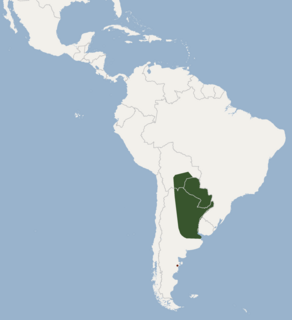
The Patagonian bonneted bat, also called the Patagonian dwarf bonneted bat, is a species of free-tailed bat found in Argentina, Bolivia and Paraguay.

The Florida bonneted bat or Florida mastiff bat is a species of bat in the genus Eumops, the bonneted bats or mastiff bats. Until recently, it was classified as a subspecies of Wagner's bonneted bat . It is endemic to southern Florida in the United States. This species has one of the smallest geographical distributions of any New World bat. It has been called "one of the most critically endangered mammal species in North America". It is protected under the Endangered Species Act.
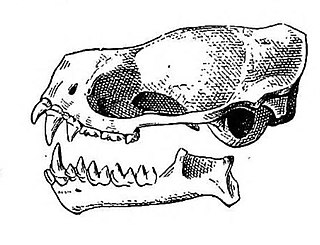
Eumops nanus is a species of bat found in Central and South America.

Eumops ferox, the fierce bonneted bat or the chestnut mastiff bat, is a species of free-tailed bat found in the Caribbean and Mexico. Until recently, it was synonymous with Wagner's bonneted bat.
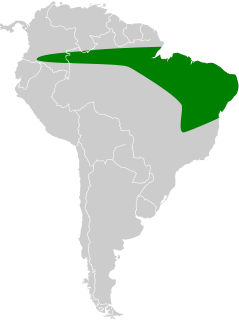
Eumops delticus is a species of free-tailed bat found in South America.

